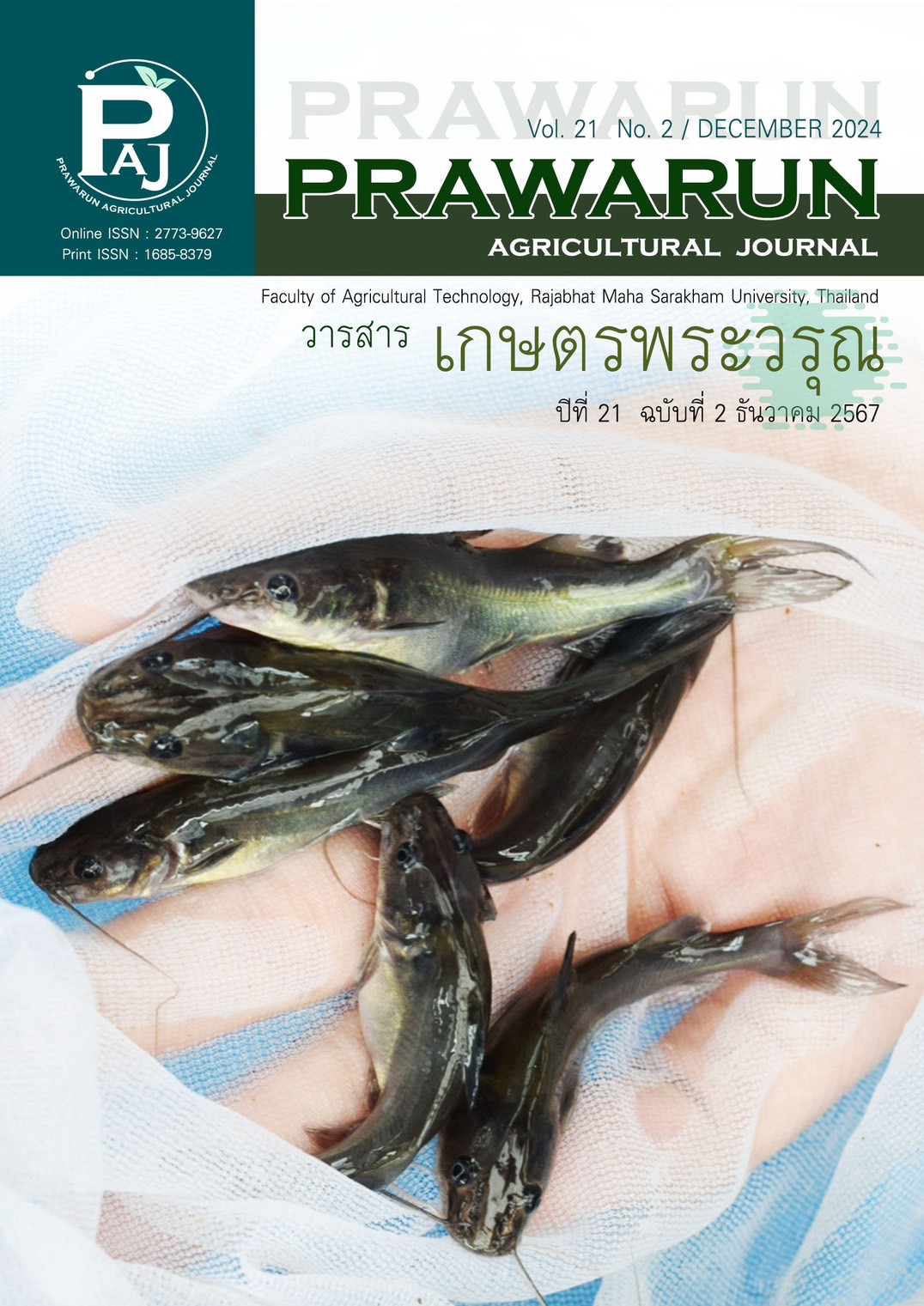Effect of Barnyardgrass seeds in rations on production performance of Kabinburi Muscovy ducks
Main Article Content
Abstract
The objective of this research was to study the effects of Barnyardgrass seeds in rations on the production performance of Kabinburi Muscovy ducks. One hundred and thirty-two ducks, aged 6 weeks and of mixed genders, were randomly allocated to 4 groups. Each group had 3 replications with 11 ducks per replication. The groups received feed mixed with Barnyardgrass seeds at four different levels as follows: the control group (no Barnyardgrass seeds), Group II (5 % Barnyardgrass seeds), Group III (9 % Barnyardgrass seeds), and Group IV (13 % Barnyardgrass seeds). The experimental period lasted 42 days. The results showed that at 6-12 weeks, the average body weight, body weight gain, average daily gain, feed conversion ratio, and feed cost per gain of Kabinburi Muscovy ducks in groups receiving feed mixed with Barnyardgrass seeds were not significantly different from those of the control group (P > 0.05). However, the average daily feed intake of Group IV was significantly higher than that of Group II, Group III, and the control group (P < 0.05). Additionally, the feed cost per gain for groups receiving Barnyardgrass seeds tended to be lower than that of the control group (P > 0.05). From this study, it can be concluded that a 13% inclusion of Barnyardgrass seeds did not affect the market weight of Kabinburi Muscovy ducks.
Article Details
References
Chimliang, T., & Luangvaree, P. (2020). Effect of the use of Ground Khaohom Mae Phaya Tongdam Paddy rice in diets on productive performance of native crossbred chicken. Rajabhat Rambhai Barni Research Journal, 14(2), 192-203. (in Thai)
Department of Livestock Development. (2002). Raising of Kabinburi Muscovy Duck. Bangkok, Thailand: The Agricultural Cooperative Federation of Thailand Publisher. (in Thai)
Nutrient Requirements Council (NRC). (1994). Nutrient requirements of poultry (9th ed.). Washington, D. C., United States: National Academy Press.
Pinsupa, J., Chindakul, A., Tanutong, A., Mahawong, T., & Intanon, S. (2022). Relationship between morphology characteristics of Barnyardgrass (Echinochloa crus-galli (L.) Beauv) and Quinclorac resistance. Thai Agricultural Research Journal, 40(1), 59-71. (in Thai) doi: 10.14456/thaidoa-agres.2022.5
Rodrigues, P. B., Junior, W. M. D., Rostagno, H. S., & Rodrigues, K. F. (2004). Energy values and digestible amino acids of Barnyardgrass seeds (Echinochloa spp.) for poultry. Revista Brasileira de Zootecnia, 33(5), 1192-1196. doi: 10.1590/S1516-35982004000500011
Statistical Analysis System (SAS). (1998). SAS User’s guide. version 6.12. North Carolina, United States: SAS Institute Inc.
Tangtaweewipat, S., Chava-Isarakul, B., Wongrueng, B., & Ya-thep, N. (1996). The use of high fiber diets in poultry. ChiangMai, Thailand: Department of Animal Science, Faculty of Agriculture, Chiangmai University. (in Thai)
Weed Science Society of Thailand. (2002). Common weeds of central Thailand. Accessed August 3, 2023. Retrieved from https://anyflip.com/xflkp/tauf. (in Thai)
Yu, J., Zhang, H., Yang, H. M., & Wang, Z. Y. (2022). Effects of dietary paddy rice on growth performance, carcass traits, bare skin color, and nutrient digestibility in geese. Poultry Science, 101(6), 101865. doi: 10.1016/j.psj.2022.101865


